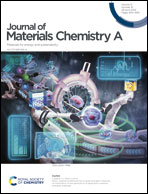Tin–lead halide perovskite solar cells with a robust hole transport layer†
Abstract
The photovoltaic performance and stability of tin–lead perovskite solar cells (PSCs) are undermined by the reaction between the perovskite layer and the commonly used hole contact, poly(3,4-ethylenedioxythiophene) : polystyrene sulfonate (PEDOT : PSS). In addition to its acidity issue, the PSS polyelectrolyte can be etched by polar solvents within the perovskite precursor, exposing the highly doped PEDOT chains and resulting in carrier quenching at the buried interface. Here, an inorganic salt, cesium carbonate (CC), is incorporated to convert the labile PEDOT : PSS mixture into a robust polymer substrate. The salt induces substantial morphological transformation in the polymer matrix with enhanced interchain coupling, rendering the PEDOT : PSS resistant to polar solvents. The modified hole contact suppresses redox reactions, chemical degradation, and recombination losses at the buried interface. Single-junction methylammonium-free tin–lead PSCs achieved an efficiency of 23.18% (certified 22.30%). The encapsulated device retained 91% of its initial efficiency after 500 hours of maximum power point operation under AM1.5G one-sun illumination.



 Please wait while we load your content...
Please wait while we load your content...